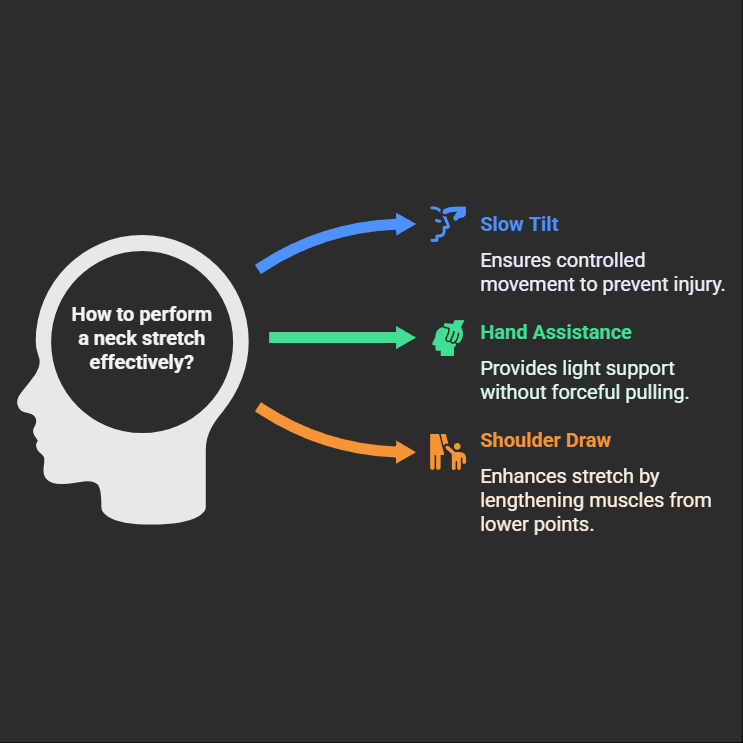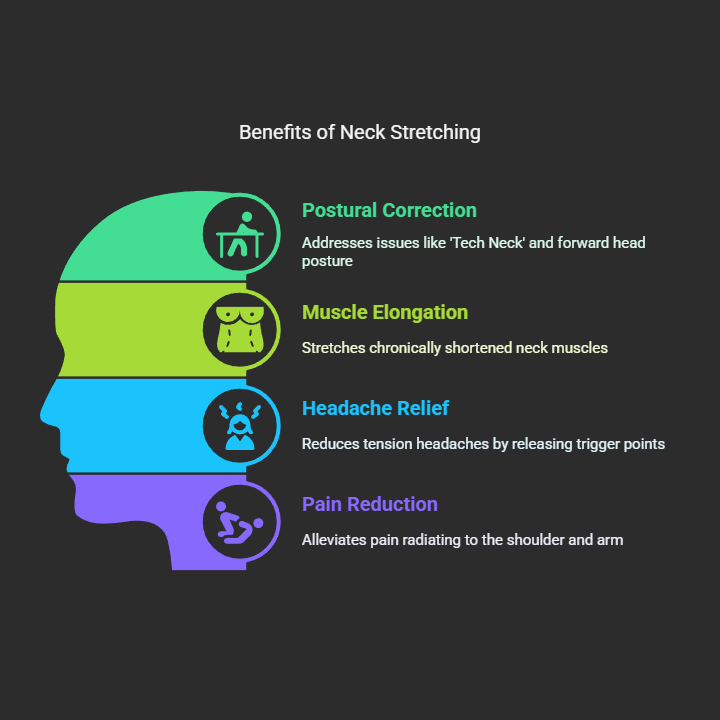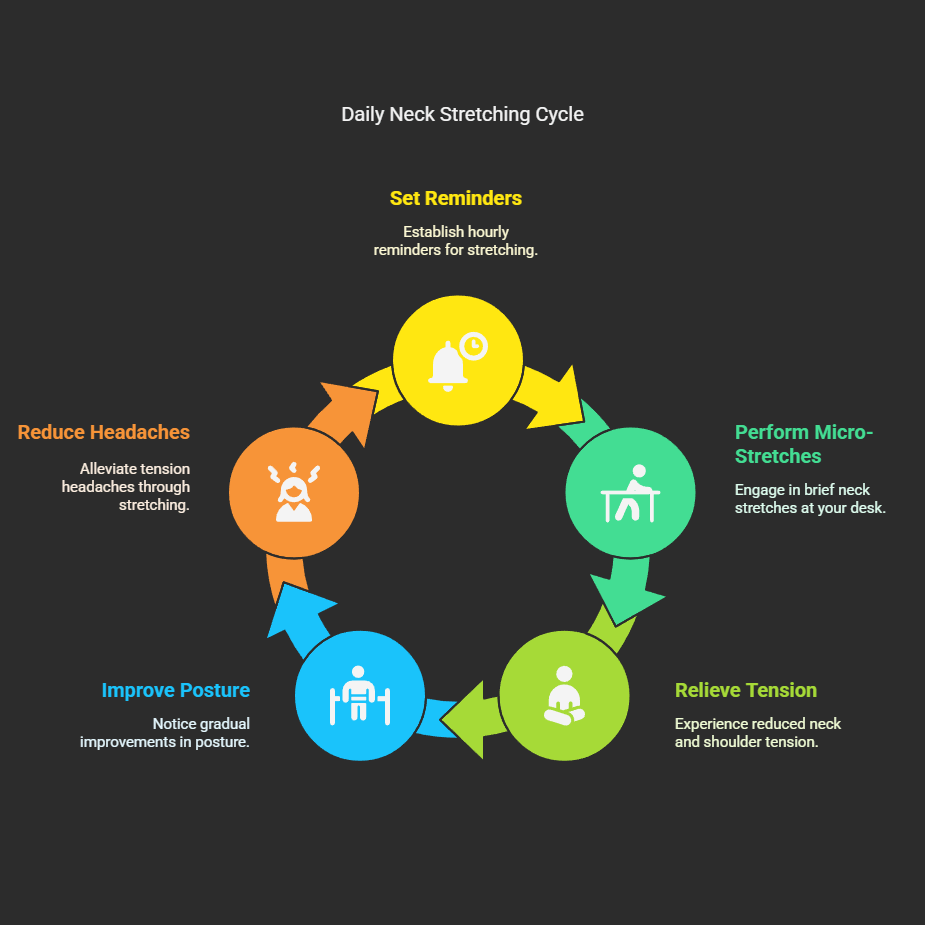Hello, I'm your health partner, a massage therapist specializing in body structure and myofascial health. In our fast-paced modern lives, 'neck discomfort' has become an almost ubiquitous complaint. Long hours spent hunched over computer screens or looking down at smartphones – these seemingly innocuous daily habits are gradually undermining our neck health, giving rise to the troublesome 'Tech Neck.' Shoulder and neck stiffness and soreness don't just affect your mood; they can also significantly reduce your quality of life. But please rest assured, you don't have to endure this silently. With the right self-care practices, restoring ease and comfort to your neck is achievable. Let's embark on this journey together towards a 'Happy Healthy Life'!
From a professional standpoint, this article will offer an in-depth look into the root causes of neck discomfort and provide a simple yet effective protocol for a neck side-bending stretch. I will explain why certain muscles become so easily tight and how this specific stretch can bring relief. Grasping these principles can significantly enhance the effectiveness of your stretches, shifting you from passively following instructions to actively participating in your own health maintenance. Together, let's discover how gentle stretching can release neck pressure and help us embrace a quality of life with greater flexibility and comfort.
Unveiling Your Neck's Secrets: Meet the 'Mighty Duo' – Its Hardest-Working Champions
Before we learn how to find relief for your neck, let's first identify two key 'culprits': the Sternocleidomastoid muscle (SCM) and the Scalene muscles. The SCM is a thick, superficial muscle located on each side of your neck, running from behind the ear down to your sternum (breastbone) and clavicle (collarbone). It's responsible for turning your head, nodding, bending your head to the side, and aiding in respiration. You can easily feel this muscle on either side of your neck; it becomes particularly noticeable when you turn your head. This versatile muscle plays a vital role in maintaining head posture and neck stability, and even contributes to chewing movements.
Another group of unsung heroes are the Scalene muscles (Scalene muscle group), deeply situated beneath the SCM and connecting your cervical vertebrae to your first and second ribs. These muscles are also involved in bending your neck to the side and rotating it, and they play a significant role in deep inhalation. The 'Tech Neck' posture so prevalent in modern life – that is, prolonged periods of looking downwards – forces both these muscle groups (SCM and Scalenes) to stay in a shortened position for extended durations. This leads to tightness, pain, and can even result in the formation of trigger points. Furthermore, chronic psychological stress can cause these muscles to contract involuntarily, worsening the discomfort. Thus, understanding their functions and the issues they encounter is the foundational step to performing effective stretches.
Neck Side-Bending Stretch: Your Path to Relief – A Complete Step-by-Step Breakdown
The main objective of the neck side-bending stretch is to gently lengthen the Sternocleidomastoid (SCM) and Scalene muscles located on the sides of your neck. This helps counteract the muscle shortening often resulting from daily stress and poor posture. To begin, whether you are in a seated or standing position, ensure your spine is neutral and your shoulders are relaxed, lowered, and away from your ears. This initial setup ensures the stretch effectively works on the target muscles while preventing any undue tension.
Next, slowly tilt your head to one side—for instance, gently leaning your right ear towards your right shoulder to stretch the muscles on the left side of your neck. The movement must be slow and controlled. You can opt to gently place the hand on the same side (e.g., your right hand if tilting right) on the top of your head, slightly off-center towards the tilt, for very light assistance. Remember, it is crucial not to pull down with force. Crucially, actively draw the opposite shoulder (e.g., your left shoulder) downwards. This action significantly boosts the effectiveness of the stretch, as it lengthens the muscles from their lower attachment points.

You should feel a gentle pulling sensation along the side of your neck, rather than sharp pain. Hold this stretch for 15 to 30 seconds, continuing to breathe normally and relax throughout. Crucially, do not hold your breath. After holding, slowly bring your head back to the neutral position, then repeat the stretch on the opposite side. Perform 2 to 4 repetitions on each side. Consistent deep breathing helps promote relaxation, supplies oxygen to your muscles, and improves the overall results of the stretch.
To target the SCM more precisely, building on the side-bend, slightly turn your head in the direction opposite to the tilt (for example, if your head is tilted to the right, turn your face slightly upwards and to the left). This can be combined with a gentle, slight chin tuck or a minimal backward tilt of the chin. For the Scalene muscles, a simple side-bend is typically quite effective. The essence of this stretch lies in the 'fix and lengthen' principle: ensure the shoulder is fixed (stabilized), and create length by moving the head further away. This is key to achieving the optimal stretching effect.
The Rewards of Stretching: Why It's Your Neck's Best Friend
Performing the neck side-bending stretch regularly and correctly can offer multiple benefits for your neck. The most direct of these is effective relief from tension and stiffness in your SCM and Scalene muscles, which in turn reduces the associated pain. Additionally, it can significantly enhance your neck's flexibility and range of motion. This allows for greater ease in daily movements like turning your head or looking sideways; for instance, checking your blind spot while driving will become less strained.
This stretch offers distinct counteractive and corrective benefits for postural issues that trouble many in modern life, such as 'Tech Neck' and forward head posture. By elongating the chronically shortened muscles at the front and sides of the neck, it aids in gradually improving postural problems caused by extended use of electronic devices and desk-bound work. Moreover, tightness in the SCM and Scalene muscles is a frequent cause of tension headaches and pain that radiates to the shoulder and arm. Stretching these muscles helps release trigger points, thereby reducing such vexing headaches and referred pain.

Avoiding Pitfalls & Prioritizing Safety: Stretch Smart and Stay Strain-Free
Although the neck side-bending stretch provides numerous benefits, performing it incorrectly can, conversely, cause injury. The foremost golden rule is to always 'Listen to Your Body.' When stretching, you should experience a gentle pull, never sharp pain, stinging sensations, or numbness. Should any of these warning signs occur, cease the stretch immediately. All movements must be performed slowly, steadily, and with control. Refrain from any sudden or abrupt motions to avoid muscle strains.
One common mistake is overstretching or forcing the movement, often stemming from the 'no pain, no gain' misconception; this can very easily cause muscle strains. Additionally, remember not to hold your breath. Doing so increases tension throughout the body, which is counterproductive to the relaxation stretching aims for. When performing the stretch, shrugging the shoulder on the side being stretched will greatly diminish its effectiveness. Instead, this shoulder should be actively kept down and relaxed. Ballistic stretching (i.e., bouncing) should also be avoided, as it may trigger a protective muscle reflex (contraction) and heighten the risk of injury.
It's also important to be mindful of your head angle. During the side-bend, avoid unconsciously bending your head too far forward, tilting it too far back, or adding unnecessary rotation, unless specifically aiming to target a muscle like the SCM with a slight turn. If you have an acute neck injury, are currently experiencing severe neck pain or inflammation, or if side-bending tends to cause dizziness, exercise caution with this stretch or avoid it entirely, and seek professional advice beforehand. When in doubt about your specific condition, consulting a healthcare provider is always the wisest approach.
Integrating Wellness into Daily Life: Making Neck Stretching a Regular Habit
To genuinely reap the benefits of neck stretching, the key is 'consistency' (持之以恆 chízhīyǐhéng) and skillfully weaving it into your daily routine. For those in office environments with prolonged periods of static work, brief yet frequent stretch breaks are more beneficial than one lengthy stretch performed sporadically. Why not set reminders for a 1-2 minute 'micro-stretch' break every hour? This can be easily accomplished right at your desk.

For the vast number of 'smartphone users' among us, this stretch is a particularly potent tool for preventing 'Tech Neck.' After prolonged use of your phone or tablet, spend a few minutes stretching your neck. At the same time, cultivate the habit of holding your devices at eye level. You can integrate these stretches with routine daily tasks: for example, while waiting for the kettle to boil, during television commercial breaks, or as part of a regular morning ritual to awaken your body and an evening routine to relax both body and mind.
Learn to listen to your body’s 'stretch cues.' When your neck feels slightly stiff, or you unconsciously find yourself wanting to rub it, that’s your signal to stretch—don’t wait for pain to arise before taking action. Connecting neck stretches with specific environmental triggers or established daily routines (e.g., each time you sit at your desk, after every phone call) is a more effective way to build the habit. This allows stretching to become a spontaneous part of your life, helping you to effortlessly embrace a 'Happy Healthy Life.'
Identifying Warning Signs: When Should You Seek Professional Help?
While self-care methods can be very beneficial, it's crucial to understand they are not a cure-all. If your neck pain actually worsens with consistent self-care (such as regular stretching), or if it continues for several weeks (for instance, longer than 2-3 weeks) without any noticeable improvement, professional help should be sought. Particular caution is warranted if the pain radiates down your arm(s) or leg(s), or if it's accompanied by numbness, tingling, or weakness in your arm(s) or hand(s).
Immediate medical attention should be sought if neck pain is accompanied by persistent headaches; if severe pain follows a trauma (like a car accident or a fall); or if there are associated systemic symptoms such as fever or unexplained weight loss. Healthcare professionals like doctors can make an accurate diagnosis, whereas physical therapists or skilled massage therapists can provide more specific manual therapies, exercise instruction, and advanced stretching techniques.
It is crucial to learn to differentiate between normal 'benign soreness' after activity and 'warning pain' that signals underlying problems. Benign soreness is usually dull, mild, and self-resolving. In contrast, warning pain might be sharp, persistent, or radiating, or it may be accompanied by the red flag symptoms previously mentioned. Recognizing this difference empowers you to make a wise decision about whether to continue with self-care or seek professional assistance, thereby ensuring your neck receives the most suitable care.
Conclusion: Embracing a More Flexible, Comfortable Neck – Parting Advice from Your Massage Therapist
To summarize, when performed correctly and consistently, the neck side-bending stretch serves as a valuable tool for relieving tension in your SCM and Scalene muscles, enhancing neck mobility, and counteracting the impacts of modern lifestyles. I wholeheartedly encourage you to integrate this stretch, along with the other supplementary self-care practices mentioned previously, into your daily routine. These small yet consistent self-care efforts can lead to significant improvements not only in your neck health but also in your overall well-being.
Based on my many years of clinical experience as a massage therapist, I've seen that targeted stretching and conscientious daily care can truly bring significant relief to individuals suffering greatly from neck problems. Our necks diligently support our heads every day, enduring all sorts of pressures. When we provide them with the dedicated care they deserve, they reciprocate with enhanced comfort and greater freedom of movement. Attaining long-term neck comfort is a continuous journey, not a quick-fix solution.
Neck problems usually develop gradually over time; therefore, the path to relief also requires both time and patience. The neck side-bending stretch promoted in this guide serves as an invaluable starting point on your journey towards a 'Happy Healthy Life.' It is my hope that you will adopt a long-term perspective on your neck health, cultivate sustainable self-care habits, and genuinely embrace a more flexible, comfortable, and vibrant version of yourself!
